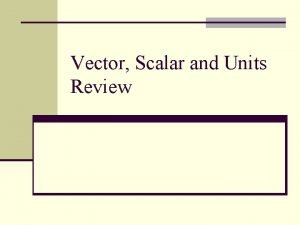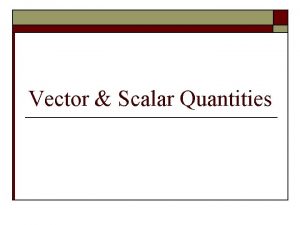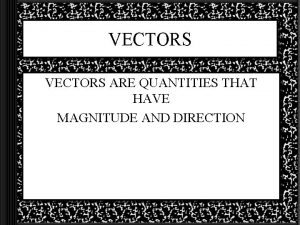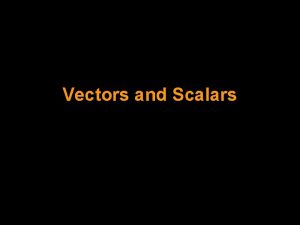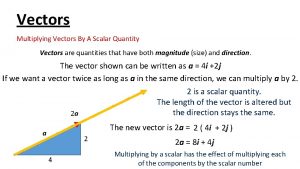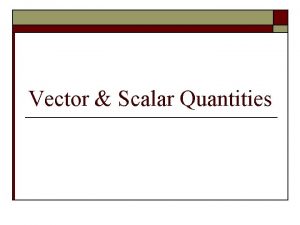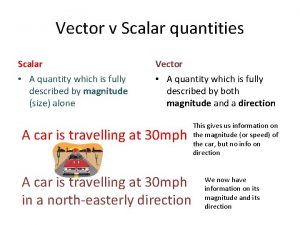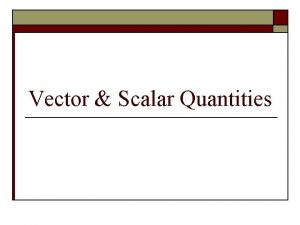INTRODUCTION TO VECTORS Vectors q Scalar quantities are













- Slides: 13

INTRODUCTION TO VECTORS

Vectors q Scalar quantities are expressed by magnitude only q Scalar quantities are mass (example: 43. 6 g), time (example: 56 s), and distance (example: 1. 4 m). q. Note that these quantities only state “how much” and are expressed by a number and a unit.

Vectors Vector quantities are expressed by magnitude and direction. One example of a vector quantity is force (example: 20 N, down). What kind of force have we studied which always acts in a downward direction? WEIGHT

Vectors � � When we describe motion of an object, sometimes direction is important and sometimes it is not. For example: We use distance to describe the change in position of an object without any particular direction. This means that distance is a scalar quantity.

VECTORS If Jackson East walks 5 blocks to school, then 5 blocks home to get his homework which he forgot, then 5 blocks back to school, he has walked a total distance of ________ blocks.

Vectors When the direction is important, we use displacement. This is the change in position in a certain direction. Displacement is a vector quantity. In the example above, if the school is east of his house, what is Jacksons’ displacement?

ØSpeed and velocity are also different. Velocity is speed in a certain direction. This means that velocity must be a vector, and speed must be a scalar quantity. Ø 55 mi/h is an example of scalar. Ø 25 m/s, south is an example of a vector. Ø

Vec t ors v. Vect o rs a re dr awn an a usi ng rr ow t ippe The d li n l engt e. repre h of of t he sent s the t he li ne direc vec tor w magnitu ti on of th hi le th e de rep re e arr o s e n t the t he q w d irect ve ry uan ti ty. ion o T u s h prob efu l fo e arr ow f r need lems i n w solving are hich to be co mb vect or s ined. v

Vectors The diagram represents an airplane flying east at 125 km/h. There is a 25 km/h tail wind. (which means that it blows in the same direction as the plane. )

Vectors Always start with a bold dot. The long vector represents the velocity of the plane. The short vector represents the velocity of the wind. Start at the dot and draw the first vector. Then place the tail of the next vector on the head of the last one. The resultant (one vector have the same effect as combined vectors) is always drawn from the starting dot to the last arrow head. This is called the head to tail method for solving vector problems.

Vectors What is the resultant of a plane flying 125 km/h due east with a tail wind blowing due east at 25 km/h? Draw a picture and solve the problem.

VECTORS What is the resultant velocity if you are driving 40 km/h due north in a sever thunderstorm if the wind is blowing due north at 3 km/h?

VECTORS What if the vectors are in opposite directions? Es muy facil!!! We’ll still draw our vectors “head to tail” and find the resultant. Here’s an example: A hiker walks 56 km due west, then turns around and walks 25 km due east. What is the hiker’s displacement? (Remember, draw the resultant from the starting dot to the head of the last vector. )
 Mikael ferm
Mikael ferm Relation between linear velocity and angular velocity
Relation between linear velocity and angular velocity Electric intensity is scalar or vector
Electric intensity is scalar or vector Examples of scalar quantities
Examples of scalar quantities Vector quantity
Vector quantity A scalar quantity has only got magnitude not
A scalar quantity has only got magnitude not 50 examples of scalar and vector quantities
50 examples of scalar and vector quantities A vector quantity has ______ and direction.
A vector quantity has ______ and direction. Magnitude of a vecotr
Magnitude of a vecotr Physical quantities of vectors
Physical quantities of vectors Scalar quantity unit
Scalar quantity unit Antiparallel vectors
Antiparallel vectors Scalar product of vectors
Scalar product of vectors Primary and secondary units
Primary and secondary units


